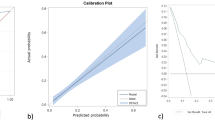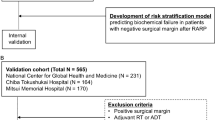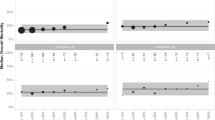Abstract
Background:
A significant number of patients with minimal lymph node disease at radical prostatectomy (RP) and pelvic lymph node dissection (PLND) have better than expected long-term outcomes. We explored whether stratification by number of positive nodes enhances our institutional prediction model for biochemical recurrence after RP.
Methods:
A total of 7789 patients underwent RP and pelvic lymph node dissection from 1995 to 2012 at a tertiary referral center. We compared two recurrence prediction models: one incorporated lymph node invasion and the other tracked the number of positive nodes. Existing and updated models’ discrimination was assessed using Harrell’s c-index and calibration. The 10-fold cross-validation was performed to correct for model overfitting.
Results:
Of the 491 patients (6.3%) harboring nodal disease, 387 (5.0%) had 1–2 positive nodes and 104 (1.3%) had ⩾3 positive nodes. Data on number of positive nodes did not improve the c-index for the cohort as a whole. When we assessed discrimination for node-positive patients only, c-index for the model with number of positive nodes was 0.01 (95% confidence interval 0.001–0.024) higher than the model with lymph node invasion. Illustrative examples were provided by reclassification tables using number of positive lymph nodes. For instance, 40 of 7789 patients would be reclassified with a cutoff point of 50% for biochemical recurrence at 1 year, and 36 of 7789 patients would be reclassified with a cutoff point of 40% for biochemical recurrence at 10 years.
Conclusions:
Stratification by number of positive lymph nodes provided additional discriminative ability for evaluating risk in node-positive patients. Pending external validation, this model could be used for patient counseling and clinical trial stratification in this subpopulation.
This is a preview of subscription content, access via your institution
Access options
Subscribe to this journal
Receive 4 print issues and online access
$259.00 per year
only $64.75 per issue
Buy this article
- Purchase on Springer Link
- Instant access to full article PDF
Prices may be subject to local taxes which are calculated during checkout
Similar content being viewed by others
References
Carlsson S, Vickers AJ, Roobol M, Eastham J, Scardino P, Lilja H et al. Prostate cancer screening: facts, statistics, and interpretation in response to the US Preventive Services Task Force Review. J Clin Oncol 2012; 30: 2581–2584.
Vickers AJ, Eastham JA, Scardino PT . Radical prostatectomy versus observation for prostate cancer. N Engl J Med 2012; 367: 1467–1468.
Briganti A, Blute ML, Eastham JA, Graefen M, Heidenreich A, Karnes JR et al. Pelvic lymph node dissection in prostate cancer. Eur Urol 2009; 55: 1251–1265.
Yossepowitch O, Eastham JA . Role of radical prostatectomy in the treatment of high-risk prostate cancer. Curr Urol Rep 2008; 9: 203–210.
Touijer K, Scardino PT . Nomograms for staging, prognosis, and predicting treatment outcomes. Cancer 2009; 115: 3107–3111.
Shariat SF, Kattan MW, Vickers AJ, Karakiewicz PI, Scardino PT . Critical review of prostate cancer predictive tools. Future Oncol 2009; 5: 1555–1584.
Kattan MW, Wheeler TM, Scardino PT . Postoperative nomogram for disease recurrence after radical prostatectomy for prostate cancer. J Clin Oncol 1999; 17: 1499–1507.
Stephenson AJ, Scardino PT, Eastham JA, Bianco FJ Jr, Dotan ZA, DiBlasio CJ et al. Postoperative nomogram predicting the 10-year probability of prostate cancer recurrence after radical prostatectomy. J Clin Oncol 2005; 23: 7005–7012.
Seiler R, Studer UE, Tschan K, Bader P, Burkhard FC . Removal of limited nodal disease in patients undergoing radical prostatectomy: long-term results confirm a chance for cure. J Urol 2014; 191: 1280–1285.
Touijer KA, Mazzola CR, Sjoberg DD, Scardino PT, Eastham JA . Long-term outcomes of patients with lymph node metastasis treated with radical prostatectomy without adjuvant androgen-deprivation therapy. Eur Urol 2014; 65: 20–25.
Carlsson SV, Tafe LJ, Chade DC, Sjoberg DD, Passoni N, Shariat SF et al. Pathological features of lymph node metastasis for predicting biochemical recurrence after radical prostatectomy for prostate cancer. J Urol 2013; 189: 1314–1318.
Palapattu GS, Allaf ME, Trock BJ, Epstein JI, Walsh PC . Prostate specific antigen progression in men with lymph node metastases following radical prostatectomy: results of long-term followup. J Urol 2004; 172: 1860–1864.
Partin AW . Know your nomograms. BJU Int 2014; 113: 849.
Vickers AJ, Fearn P, Scardino PT, Kattan MW . Why can’t nomograms be more like Netflix? Urology 2010; 75: 511–513.
Touijer KA, Rabbani F, Otero JR, Secin FP, Eastham JA, Scardino PT et al. Standard versus limited pelvic lymph node dissection for prostate cancer in patients with a predicted probability of nodal metastasis greater than 1%. J Urol 2007; 178: 120–124.
Harrell FE, Califf RM, Pryor DB, Lee KL, Rosati RA . Evaluating the yield of medical tests. JAMA 1982; 247: 2543–2546.
Bianco FJ, Scardino PT, Eastham JA . Radical prostatectomy: long-term cancer control and recovery of sexual and urinary function (“trifecta”). Urology 2005; 66: 83–94.
Ward JF, Blute ML, Slezak J, Bergstralh EJ, Zincke H . The long-term clinical impact of biochemical recurrence of prostate cancer 5 or more years after radical prostatectomy. J Urol 2003; 170: 1872–1876.
Freedland SJ, Humphreys EB, Mangold LA, Eisenberger M, Dorey FJ, Walsh PC et al. Risk of prostate cancer–specific mortality following biochemical recurrence after radical prostatectomy. JAMA 2005; 294: 433–439.
Stephenson AJ, Kattan MW, Eastham JA, Bianco FJ Jr, Yossepowitch O, Vickers AJ et al. Prostate cancer-specific mortality after radical prostatectomy for patients treated in the prostate-specific antigen era. J Clin Oncol 2009; 27: 4300–4305.
Eggener SE, Scardino PT, Walsh PC, Han M, Partin AW, Trock BJ et al. Predicting 15-year prostate cancer specific mortality after radical prostatectomy. J Urol 2011; 185: 869–875.
Messing EM, Manola J, Yao J, Kienen M, Crawford D, Wilding G et al. Immediate versus deferred androgen deprivation treatment in patients with node-positive prostate cancer after radical prostatectomy and pelvic lymphadenectomy. Lancet Oncol 2006; 7: 472–479.
Boorjian SA, Thompson RH, Siddiqui S, Bagniewski S, Bergstralh EJ, Karnes RJ et al. Long-term outcome after radical prostatectomy for patients with lymph node positive prostate cancer in the prostate specific antigen era. J Urol 2007; 178: 864–870.
Wong YN, Freedland S, Egleston B, Hudes G, Schwartz JS, Armstrong K . Role of androgen deprivation therapy for node-positive prostate cancer. J Clin Oncol 2009; 27: 100–105.
Abdollah F, Karnes RJ, Suardi N, Cozzarini C, Gandaglia G, Fossati N et al. Impact of adjuvant radiotherapy on survival of patients with node-positive prostate cancer. J Clin Oncol 2014; 32: 3939–3947.
Studer UE, Collette L, Whelan P, Albrecht W, Casselman J, de Reijke T et al. Using PSA to guide timing of androgen deprivation in patients with T0-4 N0-2 M0 prostate cancer not suitable for local curative treatment (EORTC 30891). Eur Urol 2008; 53: 941–949.
Walz J, Chun FK, Klein EA, Reuther A, Saad F, Graefen M et al. Nomogram predicting the probability of early recurrence after radical prostatectomy for prostate cancer. J Urol 2009; 181: 601–607.
Suardi N, Porter CR, Reuther AM, Walz J, Kodama K, Gibbons RP et al. A nomogram predicting long-term biochemical recurrence after radical prostatectomy. Cancer 2008; 112: 1254–1263.
Acknowledgements
DP Nguyen is a research fellow and is supported by research grants from the Nuovo-Soldati, the Arnold U und Susanne Huggenberger-Bischoff, the Bangerter Foundations and the Swiss Urological Association (Switzerland). This work was also supported by the Sidney Kimmel Center for Prostate and Urological Cancers and the Cancer Center Support Grant P30 CA008748 to PI: Craig B Thompson at the Memorial Sloan Kettering Cancer Center.
Author information
Authors and Affiliations
Corresponding author
Ethics declarations
Competing interests
The authors declare no conflict of interest.
Additional information
Supplementary Information accompanies the paper on the Prostate Cancer and Prostatic Diseases website
Supplementary information
Rights and permissions
About this article
Cite this article
Nguyen, D., Kent, M., Vilaseca, A. et al. Updated postoperative nomogram incorporating the number of positive lymph nodes to predict disease recurrence following radical prostatectomy. Prostate Cancer Prostatic Dis 20, 105–109 (2017). https://doi.org/10.1038/pcan.2016.60
Received:
Revised:
Accepted:
Published:
Issue Date:
DOI: https://doi.org/10.1038/pcan.2016.60



